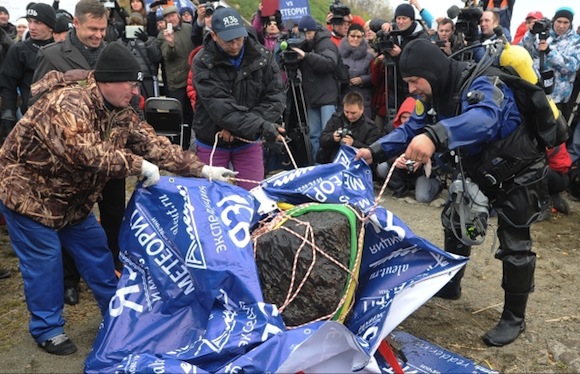Chelyabinsk: a mid-sky asteroid explosion
On February 15, 2013, a small asteroid with an estimated size of 65 feet (20 meters) entered Earth’s atmosphere. It was moving at 12 miles per second (~19 km/sec) when it struck the protective blanket of air around our planet, which did its job and caused the asteroid to explode. The bright, hot explosion took place only about 20 miles (30 km) above the city of Chelyabinsk in Russia and carried 20 to 30 times the energy of the Hiroshima atomic bomb. Its shock wave broke windows and knocked down parts of buildings in six Russian cities; furthermore, it caused some 1,500 people to seek medical attention for injuries, mostly from flying glass.

The power of the Chelyabinsk explosion
Large and small bodies from space strike Earth’s atmosphere continuously. The Nuclear Test Ban Treaty Organization operates a network of sensors that monitors Earth around the clock listening for the infrasound signature of nuclear detonations. In 2014 it stated that the sensors had recorded 26 atom-bomb-scale asteroid impacts to Earth’s atmosphere since 2000.
Still, the February 15, 2013, Russian superbolide was extremely powerful; in fact, it was the most powerful explosion caused by an asteroid since Tunguska. The Tunguska event flattened a wide area of forest and killed reindeer in Siberia in 1908.
The Tunguska event happened in a sparsely populated part of Siberia; therefore, it remained mysterious to scientists throughout the early part of the 20th century. By contrast, across a wide swath of Russia on February 15, 2013, numerous dashboard cameras and amateur photographers captured images of the incoming meteor and its effects.

Meteorites left by the explosion
After the 2013 meteor exploded, local residents and schoolchildren found meteorite fragments left in its aftermath, many located in snowdrifts. An informal market emerged for meteorite fragments.
A large number of small meteorites fell on areas west of Chelyabinsk, and, within hours of the visual sighting of the meteor, a 20-foot (6-meter) hole was discovered on the frozen surface of Lake Chebarkul in the Russian Ural Mountains. Scientists from the Ural Federal University collected 53 samples from around the hole that same day.
In June 2013, Russian scientists reported further investigation by magnetic imaging below the location of the ice hole in Lake Chebarkul. They identified a larger meteorite buried in sediments on the lake floor.
Following an operation lasting a number of weeks, on October 15, 2013, the scientists pulled up a large fragment of the meteorite from the bottom of Lake Chebarkul. It had a total mass of 1,442 pounds (654 kg) and to date remains the largest found fragment of the Chelyabinsk meteorite.

Tracking the plume in the atmosphere
NASA satellites were also able to track the meteor plume in Earth’s atmosphere. As the video below describes, they tracked and studied the meteor plume for months.
Bottom line: On February 15, 2013, a small asteroid entered Earth’s atmosphere over Russia. Dash cam footage captured the bright meteor’s explosion over the city of Chelyabinsk.
Read more: Former Apollo astronaut Rusty Schweickart describes the February 15, 2013, meteor
The post Chelyabinsk meteor: 9 years ago today first appeared on EarthSky.
0 Commentaires